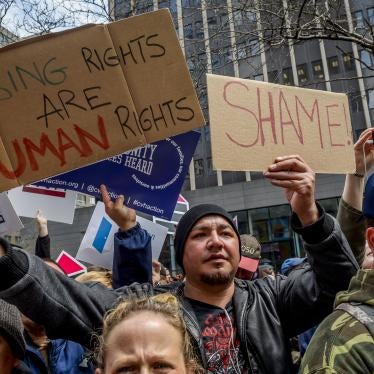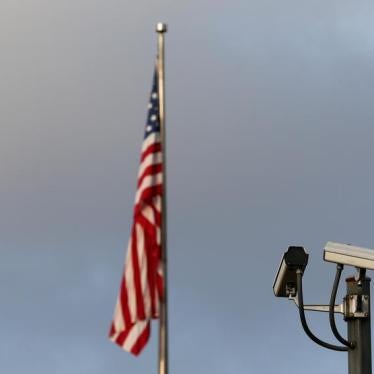Assemblymember Holden
Chair, Assembly Appropriations Committee
1021 O Street, Room 8220
Sacramento, CA 95814
Re: Human Rights Watch’s Opposition to SB 43 as amended July 13, 2023
Dear Assemblymember Holden,
Human Rights Watch has carefully reviewed SB 43[1] and the amendments to SB 43 and must respectfully voice our strong opposition. SB 43 expands the definition of “gravely disabled” increasing the number and categories of people eligible for involuntary hospitalization and conservatorship and lowers the legal standards for conservatorship proceedings. We urge you to reject this bill and instead to take a more holistic, rights-respecting approach to address the lack of resources for autonomy-affirming treatment options and affordable housing.
Proponents of SB 43 rightly raise that too many Californians are living without adequate housing and appropriate treatment.[2] However, this bill does not propose workable solutions, address the structural causes of houselessness, or provide rights-respecting treatment.
Instead, this bill expands the circumstances[3] under which the State can deprive people of their autonomy and liberty, making it easier to remove both housed and unhoused people from society.[4] Given the racial demographics of California’s unhoused population,[5] and the barriers to adequate mental health care faced by Black, Indigenous, and people of color (BIPOC) communities regardless of housing status [6] this plan is likely to disproportionately place many BIPOC Californians under state control.
Involuntary Treatment is Ineffective
SB 43 loosens the legal standard required to force a person into involuntary hospitalization and conservatorship. It does so by expanding the definition of “grave disability” to include additional reasons for involuntary holds and conservatorship, including a “severe substance use disorder.”[7] Conservatorship can potentially strip an individual of their legal capacity and personal autonomy, subjecting them to forcible medical treatment and medication, loss of personal liberty, institutionalization, and removal of power to make decisions over the conduct of their own lives in violation of international human rights law.[8]
This involuntary approach not only robs individuals of dignity and autonomy but is also likely ineffective.[9] Studies of involuntary mental health treatment have generally not shown positive outcomes.[10] Evidence does not support the conclusion that involuntary outpatient treatment is more effective than intensive voluntary outpatient treatment and, indeed, shows that involuntary, coercive mental health treatment is harmful.[11]
Similarly, studies of court ordered substance use treatment have also not shown positive outcomes.[12] Indeed, studies have correlated coerced treatment to increased occurrence of overdoses and relapse compared to voluntary treatment.[13]
Involuntary treatment is not an effective means of addressing mental health conditions or harmful use of substances. Instead, this approach risks traumatization and discouraging individuals from seeking out voluntary treatment in the future.
Involuntary Treatment Violates Human Rights
Under international human rights law, all people have the right to “the highest attainable standard of physical and mental health.”[14] Free and informed consent, including the right to refuse treatment, is a core element of that right to health.[15] Having a “substitute” decision-maker, including a judge, make orders for health care can deny a person with disabilities their right to legal capacity and unnecessarily and unduly infringe on their personal autonomy.[16]
Under the Convention on the Rights of Persons with Disabilities, governments should “holistically examine all areas of law to ensure that the right of persons with disabilities to legal capacity is not restricted on an unequal basis with others. Historically, persons with disabilities have been denied their right to legal capacity in many areas in a discriminatory manner under substitute decision-making regimes such as guardianship, conservatorship, and mental health laws that permit forced treatment.”[17] The US has signed but not yet ratified this treaty, which means it is obligated to refrain from establishing policies and legislation that will undermine the object and purpose of the treaty.[18] Such actions include creating provisions that mandate long-term substitute decision-making schemes like conservatorship or court-ordered treatment plans.
The World Health Organization has developed a new model that harmonizes mental health services and practices with international human rights law and has criticized practices promoting involuntary mental health treatments as leading to violence and abuse, rather than recovery, which should be the core basis of mental health services.[19] Recovery means different things for different people but one of its key elements is having control over one´s own mental health treatment, including the possibility of refusing treatment.
In its most recent session, the United Nations General Assembly took note of the World Health Organization’s model and adopted a resolution on mental health and psychosocial support echoing many of these themes.[20] This resolution acknowledged that “good mental health and well-being cannot be defined by the absence of a mental health condition but rather by an environment that enables persons to live a life within which their inherent dignity is respected.”[21] It also urged member states to eliminate “medical institutionalization and overmedicalization”[22] and instead create conditions where people with disabilities are able to live independently with a range of voluntary supported decision-making mechanisms available to them.[23] In contrast, SB 43’s involuntary process does not center the dignity of the person.
Further, to the extent SB 43 would perpetuate racial disparities, it also risks violating international law. Under the International Covenant on Civil and Political Rights (ICCPR), which the United States has ratified, all persons are equal before the law and are entitled without any discrimination to the equal protection of the law.[24] The International Convention on the Elimination of All Forms of Racial Discrimination (ICERD), which the US has similarly ratified, prohibits governments from engaging in acts or practices of racial discrimination against persons, groups of persons, or institutions.[25] ICERD further imposes the obligation on governments to take effective measures to amend, rescind, or nullify any laws that have the effect of creating or perpetuating racial discrimination.[26]
To comport with human rights, treatment should be based on the will and preferences of the person concerned. Disability or housing status does not rob a person of their right to legal capacity or their personal autonomy. Expansive measures for imposing treatment, like the process that SB 43 proposes, infringe on the right to health and discriminate on the basis of disability.
SB 43 Creates Due Process Concerns
The bill expands the definition of ‘gravely disabled’ in a way that creates confusion and will lead to people being detained against their will. It will also deprive people of their fundamental rights to privacy and liberty without offering voluntary community-based services.
The redefinition of “grave disability” in SB 43 encompasses multiple alternative rules and sets of criteria, rather than a single set of criteria or legal standard. SB 43 also includes vague terms that have no commonly understood meaning. For example, one set of proposed criteria for meeting the definition of “gravely disabled” under SB 43 includes evaluating whether a person can “provide for their basic personal needs for food, clothing, or shelter, personal safety or necessary medical care.”[27] There are no commonly understood meanings to the terms personal safety or necessary medical care, and the subjective, circular definitions[28] offered by SB 43 fail to create clear standards upon which those making these assessments may base their determinations. This lack of guidance creates an improper risk of arbitrary and discriminatory decision-making unmoored from consent, in violation of international human rights law. [29]
Additionally, SB 43 would create an exception[30] to normal hearsay rules for health practitioner statements in medical records discussed by an expert witness during conservatorship proceedings. The creation of this new hearsay exception will further erode the due process rights afforded to individuals in conservatorship proceedings and violates the human right of access to justice.[31]
SB 43 threatens to create a separate legal track for people with mental health conditions and harmful use of substances, without adequate process, negatively implicating basic rights.[32] Even with stronger judicial procedures, this program would remain objectionable because it expands the ability of the state to force people into involuntary treatment.
SB 43 Will Harm Unhoused and BIPOC Community Members
Despite the rhetoric of its proponents,[33] SB 43 will not help unhoused community members living with untreated or undertreated mental health and harmful substance use conditions. Decades of research shows that treatment is far more effective when individuals are safely housed in permanent affordable housing.[34] In contrast, expanding involuntary treatment mechanisms that risk enmeshing people in cycles of institutionalization, without housing support, will only serve to destabilize them and their communities.
Due to a long history of racial discrimination in housing, employment, access to health care, policing, and the criminal legal system, people from BIPOC communities have much higher rates of houselessness than their overall share of the population.[35] SB 43 in no way addresses the conditions that have led to these high rates of houselessness in communities of color. Instead, it proposes a system of state control over individuals that will compound the harms of houselessness.
Further, extensive research shows that due to bias, misinterpretation of trauma, and a lack of cultural competency, mental health professionals over-diagnose and misdiagnose Black and Latinx populations with certain mental health conditions at much higher rates than they do white populations.[36] One meta-analysis of over 50 separate studies found that Black people are diagnosed with schizophrenia at a rate nearly 2.5 times greater than white people.[37] A 2014 review of empirical literature on the subject found that Black people were diagnosed with psychotic disorders three to four times more frequently, and Latinx people approximately three times more frequently, than white people.[38] Therefore, SB 43 risks placing a disproportionate number of BIPOC community members under involuntary state control.
California Should Invest in Voluntary Treatment and Supportive Services
Californians lack adequate access to supportive mental health care and treatment.[39] However, this program does not increase that access.
Investing in involuntary treatment ties up resources that could otherwise be invested in voluntary treatment and the services necessary to make that treatment effective.[40] California should provide well-resourced holistic community-based voluntary options and remove barriers to evidence-based treatment to support people living with mental health conditions and harmful substance use who might also face other forms of social exclusion. Such options should be coupled with investment in other social supports and housing.
Expanding forced treatment is a regressive, costly, and inequitable approach to addressing the structural barriers that keep communities from thriving. We respectfully urge you to reject SB 43 and instead direct resources to making voluntary treatment, housing, and other supportive services accessible to all.
Sincerely,
Olivia Ensign
Senior Advocate/Researcher
US Program
Human Rights Watch
John Raphling
Associate Director
US Program
Human Rights Watch
[1] California SB 43, “Behavioral Health” 2023, https://leginfo.legislature.ca.gov/faces/billNavClient.xhtml?bill_id=202320240SB43 (accessed July 6, 2022).
[2] “Behavioral Health Reform Advances in State Senate,” California State Senator Susan Talamantes Eggman Press Release, April 23, 2023, https://sd05.senate.ca.gov/news/behavioral-health-reform-advances-state-senate (accessed July 3, 2023).
[3] Ibid.
[4] See Thomas Curwen, “Legislators propose changes to California’s conservatorship law,” Los Angeles Times, March 1, 2023, https://www.latimes.com/california/story/2023-03-01/legislators-propose-changes-to-californias-conservatorship-law (accessed August 1, 2023); “Behavioral Health Reform Advances in State Senate,” Senator Eggman press release https://sd05.senate.ca.gov/news/behavioral-health-reform-advances-state-senate.
[5] Los Angeles Homeless Services Authority, “Report and Recommendations of the Ad Hoc Committee on Black People Experiencing Homelessness,” December 2018, https://www.lahsa.org/documents?id=2823-report-and-recommendations-of-the-ad-hoc-committee-on-black-people-experiencing-homelessness (accessed April 12, 2022).
[6] Charles M. Olbert, Arundati Nagendra, and Benjamin Buck, “Meta-analysis of Black vs. White racial disparity in schizophrenia diagnosis in the United States: Do structured assessments attenuate racial disparities?,” Journal of Abnormal Psychology 127(1) (2018): 104-115, accessed April 12, 2022, doi: https://doi.org/10.1037/abn0000309; Robert C. Schwartz and David M. Blankenship, “Racial disparities in psychotic disorder diagnosis: A review of empirical literature,” World Journal of Psychiatry 4 (2014): 133-140, accessed April 12, 20220, doi: https://doi.org/10.5498/wjp.v4.i4.133.
[7] SB 43, Sec 2, 5008(h)(1)(A).
[8] California Welfare and Institutions Code Section 5350—5372, https://leginfo.legislature.ca.gov/faces/codes_displaySection.xhtml?lawCode=WIC§ionNum=5357 (accessed April 12, 2022).
[9] Sashidharan, S. P., Mezzina, R., & Puras, D., “Reducing coercion in mental healthcare,” Epidemiology and psychiatric sciences, 28(6) (2019): 605–612, accessed April 12, 2022, https://doi.org/10.1017/S2045796019000350 (“Available research does not suggest that coercive intervention in mental health care is “clinically effective, [will] improve patient safety or result in better clinical or social outcomes.”).
[10] Sashidharan, S. P., Mezzina, R., & Puras, D., “Reducing coercion in mental healthcare,” Epidemiology and Psychiatric Sciences, 28(6) (2019): 605–612, accessed May 5, 2022, doi: https://doi.org/10.1017/S2045796019000350; Richard M. Ryan, Martin F. Lynch, Maarten Vansteenkiste, and Edward L. Deci, “Motivation and Autonomy in Counseling, Psychotherapy, and Behavior Change: A Look at Theory and Practice,” Invited Integrative Review 39(2) (2011): 193–260, accessed May 5, 2022, doi: https://doi.org/10.1177/0011000009359313; McLaughlin, P., Giacco, D., and Priebe, S., “Use of Coercive Measures during Involuntary Psychiatric Admission and Treatment Outcomes: Data from a Prospective Study across 10 European Countries,” Plods one 11(12) (2016), accessed May 5, 2022, doi: https://doi.org/10.1371/journal.pone.0168720 (“All coercive measures are associated with patients staying longer in hospital, and seclusion significantly so, and this association is not fully explained by coerced patients being more unwell at admission.”).
[11] Joseph P. Morrissey, et al., “Outpatient Commitment and Its Alternatives: Questions Yet to Be Answered,” Psychiatric Services (2014): 812-814, doi: https://doi.org/10.1176/appi.ps.201400052; S.P. Sashidharan, et al., “Reducing Coercion in Mental Healthcare,” Epidemiology and Psychiatric Sciences 28 (2019): 605-612, doi: https://doi.org/10.1017/s2045796019000350.
[12] D. Werb, et al., “The effectiveness of compulsory drug treatment: A systematic review,” International Journal of Drug Policy, (February 2016), doi: https://doi.org/10.1016/j.drugpo.2015.12.005; (“Only 22% of studies reviewed showed positive outcomes for compulsory treatment. The rest showed either negative impact, no impact, or inconclusive data.”). See also, Human Rights Watch, Every 25 Seconds: The Human Toll of Criminalizing Drug Use in the United States, ISBN: 978-1-6231-34105, October 12, 2016, https://www.hrw.org/news/2016/10/12/us-disastrous-toll-criminalizing-drug-use , pp. 167- 176; Revoked: How Probation and Parole Feed Mass Incarceration in the United States, ISBN: 978-1-62313-8400, July 31, 2020, https://www.hrw.org/news/2020/07/31/us-probation-parole-feed-mass-incarceration-crisis, pp. 170-79; Jasmine L. Tyler (Human Rights Watch), "Criminal justice reformers are hooked on drug courts, they should kick the habit,” op-ed, The Hill, August 5, 2017, https://www.hrw.org/news/2017/08/05/criminal-justice-reformers-are-hooked-drug-courts-they-should-kick-habit.
[13] Monica Bharel, “An Assessment of Opioid-Related Deaths in Massachusetts (2013-2014)”, p. 49, https://www.mass.gov/files/documents/2016/09/qb/dph-legislative-report-chapter-55-opioid-overdose-study-9-15-2016.pdf; Beletsky, et. al, “Expanding Coercive Treatment is the Wrong Solution for the Opioid Crisis,” Health Affairs, February 11, 2016, https://www.healthaffairs.org/content/forefront/expanding-coercive-treatment-wrong-solution-opioid-crisis-updated; Claude Rafful et al., “Increased non-fatal overdose risk associated with involuntary drug treatment in a longitudinal study with people who inject drugs,” Addiction, Vol. 113, Iss. 6, (June 2018); Human Rights Watch, Revoked, pp. 170-79.
[14] International Covenant on Economic, Social and Cultural Rights, (ICESCR), adopted December 16, 1966, G.A. Res. 2200A (XXI), 21 U.N. GAOR Supp. (No. 16) at 49, U.N. Doc. A/6316 (1966), 993 U.N.T.S. 3, entered into force January 3, 1976, signed by the United States on October 5, 1977, Art. 12(1), https://www.ohchr.org/en/professionalinterest/pages/cescr.aspx (accessed May 5, 2022).
[15] Human Rights Council; United Nations, General Assembly, “Report of the Special Rapporteur on the right of everyone to the enjoyment of the highest attainable standard of physical and mental health,” March 28, 2017, https://undocs.org/en/A/HRC/35/21, para. 63. See also, Convention on the Rights of Persons with Disabilities (CPRD), adopted January 24, 2007, A/RES/61/106, entered into force May 3, 2008, signed by the United States on July 30, 2009, http://www.unhcr.org/refworld/docid/45f973632.html , art. 12 read in conjunction with art. 25; Committee on the Rights of Persons with Disabilities: General comment No. 1 (2014), May 19, 2014, http://daccess-ods.un.org/access.nsf/Get?Open&DS=CRPD/C/GC/1&Lang=E (accessed May 5, 2022), para. 31, 41.
[16] Convention on the Rights of Persons with Disabilities, art. 12; Committee on the Rights of Persons with Disabilities: General comment No. 1 (2014), May 19, 2014, para. 7.
[17] Committee on the Rights of Persons with Disabilities: General comment No. 1 (2014), May 19, 2014, para. 7.
[18] See Vienna Convention on the Law of Treaties (1969), art. 18, https://legal.un.org/ilc/texts/instruments/english/conventions/1_1_1969.pdf. The Vienna Convention is recognized as customary international law.
[19] World Health Organization and QualityRights, “Freedom from coercion, violence, and abuse,” 2019, https://apps.who.int/iris/bitstream/handle/10665/329582/9789241516730-eng.pdf?sequence=5&isAllowed=y (accessed May 5, 2022), p. 2, 8, 22.
[20] UN General Assembly, Mental Health and Psychological Support, G.A. Res. 77/300, U.N. Doc. A/77/L.77 (June 19, 2023), https://documents-dds-ny.un.org/doc/UNDOC/GEN/N23/189/19/PDF/N2318919.pdf?OpenElement, fifth to eighth preambular paragraphs, (accessed August 2, 2023).
[21] Ibid., p.2.
[22] Ibid., p.5.
[23] Ibid.
[24]International Covenant on Civil and Political Rights (ICCPR), adopted December 19, 1966, G.A. Res. 2200A (XXI), 21 U.N. GAOR Supp. (No. 16) at 52, U.N. Doc. A/6316 (1966), 999 U.N.T.S. 171 (entered into force March 23, 1976), ratified by the United States on June 8, 1992, art. 26.
[25] International Convention on the Elimination of All Forms of Racial Discrimination (ICERD), adopted December 21, 1965, G.A. Res. 2106 (XX), annex, 20 U.N. GAOR Supp. (No. 14) at 47, U.N. Doc. A/6014 (1966), 660 U.N.T.S. 195 entered into force January 4, 1969, ratified by the United States on October 21, 1994, art. 2.
[26] Ibid., art. 2(1)(c).
[27] SB 43 Section. 2, 5008 (h)(1)(A).
[28] SB 43 Section. 2, 5008 (p)(q).
[29] See UN Human Rights Council, Report of the Special Rapporteur on the right of everyone to the enjoyment of the highest attainable standard of physical and mental health (March 28, 2017), para. 63, https://undocs.org/en/A/HRC/35/21 (accessed August 2, 2023).
[30] SB 43, Sec. 3, 5122 (a).
[31] Convention on the Rights of Persons with Disabilities, art. 13.
[32] UN Committee on the Rights of Persons with Disabilities, “Guidelines on article 14 of the Convention on the Rights of Person with Disabilities: The right to liberty and security of persons with disabilities,” (September 2015) para. 14. https://www.ohchr.org/Documents/HRBodies/CRPD/14thsession/GuidelinesOnArticle14.doc
[33] Curwen, “Legislators propose changes to California’s conservatorship law,” Los Angeles Times “Behavioral Health Reform Advances In State Senate,” Senator Eggman press release, https://sd05.senate.ca.gov/news/behavioral-health-reform-advances-state-senate.
[34] See, e.g., Collins, S., et al. “Project-based Housing First for Chronically Homeless Individuals with Alcohol Problems: Within-Subjects Analyses of 2-Year Alcohol Trajectories,” (2012), American Journal of Public Health, 102 (3), 511-519; Greenwood,R.M., Schaefer-McDaniel, N.J., Winkel, G., & Tsemberis, S.J., “Decreasing Psychiatric Symptoms by Increasing Choice in Services for Adults with Histories of Homelessness,” (2005), American Journal of Community Psychology, 36 (3/4), 223-238; Seidman et al., “The Effect of Housing Interventions on Neuropsychological Functioning Among Homeless Persons with Mental Illness,” (2003), Psychiatric Services, 54(6), 905-908.
[35] Kate Cimini, “Black People Disproportionately Homeless in California,” CalMatters, October 5, 2019, , https://calmatters.org/california-divide/2019/10/black-people-disproportionately-homeless-in-california/ (about 6.5% of Californians identify as black or African American, but they account for nearly 40% of the state’s homeless population); Esmeralda Bermudez & Ruben Vives, “Surge in Latino homeless population ‘a whole new phenomenon,” Los Angeles Times, June 18, 2017, https://www.latimes.com/local/california/la-me-latino-homeless-20170618-story.html; (accessed August 2, 2023); Los Angeles Homeless Services Authority, Report and Recommendations of the Ad Hoc Committee on Black People Experiencing Homelessness, (Dec. 2018), https://www.lahsa.org/documents?id=2823-report-and-recommendations-of-the-ad-hoc-committee-on-black-people-experiencing-homelessness (accessed August 2, 2023).
[36] Charles M Olbert et al., “Meta-analysis of Black vs. White Racial Disparity in Schizophrenia Diagnosis in the United States: Do Structured Assessments Attenuate Racial Disparities?”, 127 Journal of Abnormal Psychology 104- 15 (2018); Robert C. Schwartz & David M. Blankenship, “Racial Disparities in Psychotic Disorder Diagnosis: A Review of Empirical Literature,” World J. of Psych. 4 133-40 (2014).
[37] Charles M Olbert et al., “Meta-analysis of Black vs. White Racial Disparity in Schizophrenia Diagnosis,” at 104- 15.
[38] Scwartz & Blankenship, “Racial Disparities in Psychotic Disorder Diagnosis,” at 133-40.
[39] Liz Hamel, Lunna Lopes, Bryan Wu, Mollyann Brodie, Lisa Aliferis, Kristof Stremikis and Eric Antebi, “Low-Income Californians and Health Care,” Kaiser Family Foundation, June 7, 2019, Figure 7, https://www.kff.org/report-section/low-income-californians-and-health-care-findings/ (accessed May 5, 2022). (“A majority of low-income Californians (56 percent) say their community does not have enough mental health care providers to serve the needs of local residents.”).
[40] Physicians for Human Rights, “Neither Justice nor Treatment: Drug Courts in the United States,” June 2017, https://phr.org/wp-content/uploads/2017/06/phr_drugcourts_report_singlepages.pdf (accessed May 5, 2022), p. 3.







